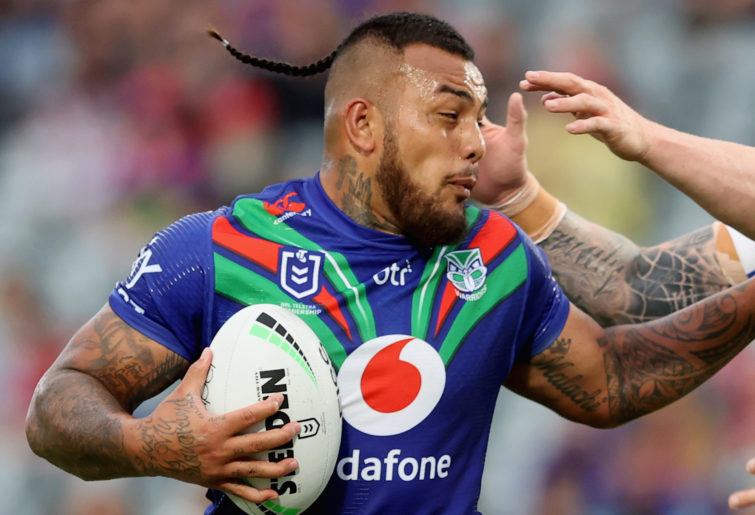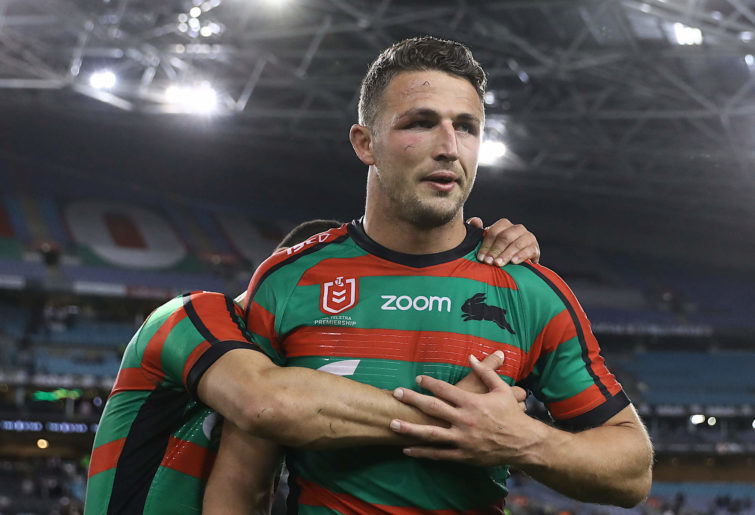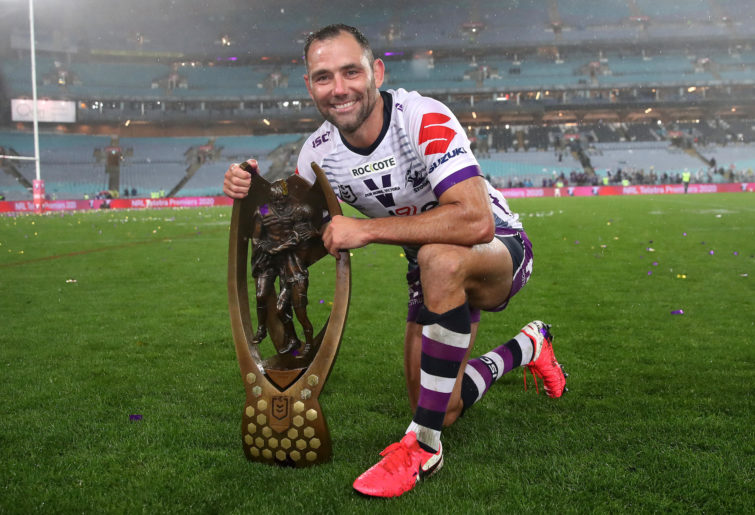The NRL may just have slowed the extinction of the genuine big man from the game of rugby league.
Already under siege as a result of ever shrinking interchanges, the onset of continual set restarts instead of penalties saw the strategic value of the genuinely big unit rapidly evaporating.
The big man was in real danger of being wiped out.
The NRL has been all about opening the game up and getting the little man back as a real feature of the game.
After years of the game being dominated by the wrestling and slowing tactics – best demonstrated by the Melbourne Storm’s excellent execution of Bellamy Ball – we all really loved the idea of a more open, running game.
However, their chosen method to realise that goal turned out to be total oversteer.
Fortunately the NRL have now worked out that set restarts weren’t necessarily the panacea that was envisaged and have sensibly modified one of the rules they introduced last year.
In season 2022 the referees will once more be allowed to award penalties – instead of set restarts – to teams trying to get the ball out of their defensive 40 metre zone. This adjustment has been a total no brainer, virtually from the moment the NRL decreed only a set restart could be given.
It was obvious to any half-intelligent coach that assuring a fully set defensive line as soon as possible could be achieved by blunting their opponents kick returns by nefarious means. The benefit far outweighed the cost of their players having to make a few extra tackles.
In fact, it was the best value in town.
In the endless battle for field position, kick return metres are absolutely vital. If there is no chance that your side won’t concede a break in play to the opposition and/or lots of metres through penalty a kick for touch, of course you are going to instruct your charges to stand offside and lie on the tackled kick return player until you were forcibly removed.
It gave you plenty of time to get your defence set, and a set defence doesn’t concede too many tries.
You’d be mad if you didn’t do it.
And that’s exactly what transpired.
While it took some sides a bit longer to catch on, the Melbourne Storm, Sydney Roosters, Penrith Panthers and Manly Sea Eagles were onto the tactic straight out of the blocks in NRL season 2021.
Not only did this tactic allow sides to really blunt NRL HQ’s desired open football that often results from kick returns, it really hurt the game’s big men.
As long as I’ve been following the game, a key tactic has been to boot the hell out of the Steeden on the last tackle. Not just to get field position, but also make your opponent’s Big Pigs have to travel as far as possible to get back to the play, and through that to wear them out.

(Photo by Ashley Feder/Getty Images)
While big forwards and outside backs are often not each other’s biggest fans, a big boned forward loves nothing more that having wingers and a fullback who get big kick return metres. The bigger the kick return, the shorter the distance they have to lug their bulk. If they get lucky they’ll barely have to track back at all.
It should come as no surprise to anyone that seven of last year’s top eight sides were the best kick returning sides. It should be even less of a surprise that the two sides that met in the decider were the two best at it.
And of course the premiers were clearly the best at gaining the most metres on kick returns – by quite a stretch too. The Panthers were 21 per cent better at kick returns than their closest opponents and it was the bedrock on which their premiership success was based.
Dylan Edwards, Stephen Crichton and Brian To’o were the best trio for kick return metres and you can bet that James Fisher-Harris and Moses Leota bought them quite a few drinks post the 2021 season.
However, they were really the only side to overcome the cynical tactics that beset the game as a result of the set restarts being the only punishment for deliberately cheating post your sides clearing kick.
Most other sides really struggled. And as a result the big forwards really struggled.
That was a dreadful thing to happen to the game.
The big man has long been a massive ornament to rugby league, the game we love.
Since I started watching the game I have been transfixed by the sight of a huge unit who was born when meat was cheap smashing into a wall of defenders as hard and fast as he can. The smash of body on body was unlike anything I’d seen in any other sport and it fascinated and enthralled me.
My earliest memories were watching Noel ‘Crusher’ Cleal on the burst, Stan Jurd hurling his keg-like frame into defenders silly enough to try and stop him, and the mass of hair and meat that was the great Geoff Robinson launching himself like a berserker.
It was pure magic.
The fans love a big human. Steve Roach, Glenn Lazarus, Shane Webke, Reuben Wiki, Petero Civoneciva, Willie Mason, Les Davidson, Ian Roberts, Fui Fui Moi Moi, Junior Paulo, Adam Ritson, Dave Taylor, Matt Scott, Craig Young, Artie Beetson, Sam Burgess, Mark Bugden and George Rose are just some of names that spring readily to mind.

(Photo by Mark Metcalfe/Getty Images)
We will remember for years to come Paul Harragon and Mark Carroll smashing seven colours of shite out of each other.
It is the stuff of legend.
But we can’t see more legends of that like created if the game becomes too fast for them.
One of my very ever favourite moments in watching rugby league was witnessing the Cowboys’ Tariq Sims and the Raiders’ Tom Learoyd-Lahrs collide at top speed at Canberra Stadium.
The ground shook. The crowd roared.
I’ll never forget the noise.
Another favourite moment I’m sure many of you will have seen played out as well.
It was halftime in a packed out Panthers Stadium and the kids were out on the field for a game. These kids were a bit older and a bit better than the standard mini league. Maybe under-8s or 9s. There was some structure and some skill in attack and defence.
On one side, there was a very big unit. You could see that he wasn’t fast or that fit. But he was out there with his mates, wearing his headgear and having a go. His side got the ball and it made its way to the kid and – from behind halfway – he set his sights on the try line.
His opponents threw everything at him to try and stop his slow but determined drive, but still he ploughed forward. The huge crowd began to roar him on towards his unlikely goal and – as they did – the kid grew in spirit and stature. There must have been five defenders on him as he crashed over for the try.
The crowd went berserk and his teammates mobbed him as their hero. It was pure magic.
We can’t lose that from our game at any level if we truly care about it.
The reintroduction of penalties for sides trying to get out of their defensive 40 won’t just give the Pigs some badly needed respite, it’ll probably see a lot more broken field football.
As well, it will also see the veteran players last longer.
It is bad enough having to cover more and more ground and do more and more minutes when you are a big boned lad, it is even worse when you’ve crossed into your 30s.
V’landys Ball was the death knell of the veteran.
All the skill, tricks and leadership that old stagers bring to the game was in danger of being lost because those pros were being outweighed by the cons of them becoming ineffective through exhaustion.
The likes of Cam Smith, Artie Beetson, Jeremy Smith and Paul Gallen played great football well into their late 30s.

(Photo by Cameron Spencer/Getty Images)
This season at 34 years old the Broncos’ David Mead is the game’s elder statesman, with Jake Granville, James Tamou, Jared Waerea-Hargreaves, Kevin Naiqama and Aidan Tolman just behind him on 33. Of those six players, only Tamou and JWH are certainties to get lots of games.
Of the 480 players listed in the top 30 squads of the 16 NRL teams, only 59 (12.3 per cent) will be over 30 this season. 46 of them (9.1 per cent) are likely to be regular first graders.
And just 37 of them (7.7 per cent) are forwards.
While average 30-year-old-plus players per side is 2.3, the bell curve is a wide one.
The Dragons and the Rabbitohs will be hoping that the end of compulsory restarts will see their “Dad’s armies” – featuring seven and six 30-plus players respectively – prosper through their skill and experience, borne of many a campaign.
Conversely, the Parramatta Eels and Penrith Panthers do not have a single player who is 30 years old or older in their squad and they are betting that the key to winning games will be all about speed and repeat efforts.
The other teams are somewhere in between those two points. (See table below for the full breakdown by team.)
However season 2022 plays out, my solemn wish is that the NRL will continue to be blessed with big boned boofheads charging with vigour into the fray for many, many years to come.
I don’t even want to imagine rugby league without them.
| Team
| Players over 30
| Players
| Forwards over 30
| Definite 1st grade over 30
|
| Dragons |
7 |
(Ben Hunt, Aaron Woods, Andrew McCullough, Jack De Belin, George Burgess*, Tariq Sims, Josh McGuire) |
6 (Woods, McCullough, De Belin, G Burgess*, Sims, McGuire) |
7 (Hunt, Woods, McCullough, De Belin, G Burgess*, Sims, McGuire) |
| Rabbitohs |
6 |
(Cody Walker, Josh Mansour, Damien Cook, Mark Nicholls, Michael Chee Kam, Tom Burgess*) |
3 (Damien Cook, Mark Nicholls, Tom Burgess*) |
4 (Walker, Cook, Nicholls, Tom Burgess*) |
| Sharks |
5 |
(Matt Moylan, Aidan Tolman, Andrew Fifita, Dale Finucane, Wade Graham) |
4 (Tolman, Fifita, Finucane, Graham) |
2 (Finucane, Graham) |
| Cowboys |
5 |
(Ben Hampton*, Chad Townsend, Kyle Feldt, Jake Granville, Jordan McLean) |
2 (Granville, McLean) |
4 (Townsend, Feldt, Granville, McLean) |
| Raiders |
5 |
(Jarrod Croker, Jordan Rapana, Sam Williams, Elliott Whitehead, Josh Hodgson) |
2 (Whitehead, Hodgson) |
4 (Croker, Rapana, Whitehead, Hodgson) |
| Roosters |
5 |
(Daniel Tupou, Kevin Naiqama, Luke Keary, Jared Waerea-Hargreaves, Siosiua Taukeiaho) |
2 (Waerea-Hargreaves, Taukeiaho) |
4 (Tupou, Keary, Waerea-Hargreaves, Taukeiaho) |
| Storm |
4 |
(Jesse Bromwich, Kenny Bromwich, Felise Kaufusi*, Tom Eisenhuth*) |
4 (J Browich, K Bromwich, Kaufusi, Eisenhuth) |
4 (J Browich, K Bromwich, Kaufusi, Eisenhuth) |
| Broncos |
4 |
(Adam Reynolds, Albert Kelly, David Mead, Ryan James*) |
1 (James) |
1 (Reynolds) |
| Sea Eagles |
4 |
(Daly Cherry-Evans, Jorge Taufua, Kieran Foran, Martin Tapau) |
1 (Tapau) |
3 (Cherry-Evans, Foran, Tapau) |
| Bulldogs |
3 |
(Ava Seumanufagai, Josh Jackson, Paul Vaughn) |
3 (Seumanufagai, Jackson, Vaughn) |
3 (Seumanufagai, Jackson, Vaughn) |
| Titans |
3 |
(Jarrod Wallace, Isaac Liu, Kevin Proctor) |
3 (Wallace, Proctor, Liu) |
3 (Wallace, Proctor, Liu) |
| Knights |
3 |
(Tyson Frizzell, Dane Gagai, Suaso Sue*) |
2 (Frizzell, Sue) |
2 (Frizzell, Gagai) |
| Warriors |
3 |
(Shaun Johnson, Ben Murdoch-Masila, Tohu Harris) |
2 (Murdoch-Masila, Harris) |
3 (Johnson, Murdoch-Masila, Harris) |
| Wests Tigers |
2 |
(James Tamou, Tyrone Peachey) |
2 (Tamou, Peachey) |
2 (Tamou, Peachey) |
| Eels |
0 |
Nil |
Nil |
nil |
| Panthers |
0 |
Nil |
Nil |
Nil |
| Total
| 59 |
|
37 |
46 |
| Average
| 3.7 |
|
2.3 per team |
2.9 per team |
| % of total NRL squads
| 12.3% |
|
7.7% |
9.6% |
| *will turn 30 early in season 2022. |
|































































































